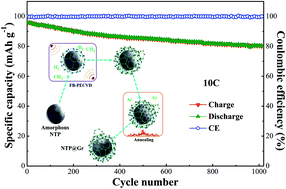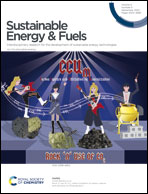Plasma assisted fabrication of a NaTi2(PO4)3@Gr nanocomposite for high-rate and long cycle-life sodium-ion batteries
Abstract
NASICON-type NaTi2(PO4)3 (NTP) has gained enormous attention as an anode material for sodium-ion batteries (SIBs), thanks to its open 3D framework and excellent electrochemical performance. Nevertheless, low electrical conductivity, agglomeration, and dissolution of Ti ions in electrolytes seriously impair the rate and cycling performance of NTP. Here, monodisperse sphere or rugby-shaped NTP nanoparticles with an average size of about 100 nm are synthesized by a solvothermal method, and then graphene is uniformly coated on the nanoparticles using fluidized bed plasma-enhanced chemical vapor deposition (FB-PECVD). A sodium-ion semi-battery based on the NTP@Gr nanocomposite shows a high reversible capacity (132 mA h g−1@0.5C, 115.1 mA h g−1@1C, 109.3 mA h g−1@2C, 100.7 mA h g−1@5C, 95.9 mA h g−1@10C, 67.2 mA h g−1@20C, and 53.9 mA h g−1@50C), high initial coulombic efficiency (93%), and long-term capacity retention of 83.8% after 1000 cycles at 10C, mainly attributed to its conformal graphene coating and graphene branches. This novel nanostructure provides a promising pathway for developing high performance NASICON-type electrode materials for sodium storage.



 Please wait while we load your content...
Please wait while we load your content...